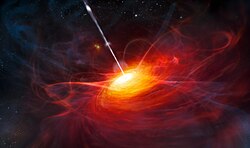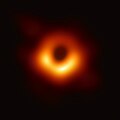| LQG | Date | Mean Distance | Dimension | # of quasars | Notes |
|---|
Webster LQG
(LQG 1) | 1982 | z=0.37 | 100 Mpc | 5 | First LQG discovered. At the time of its discovery, it was the largest structure known. [1] [4] [6] |
Crampton–Cowley–Hartwick LQG
(LQG 2, CCH LQG, Komberg-Kravtsov-Lukash LQG 10) | 1987 | z=1.11 | 60 Mpc | 28 | Second LQG discovered [1] [4] [7] |
Clowes–Campusano LQG
(U1.28, CCLQG, LQG 3) | 1991 | z=1.28 | - longest dimension: 630 Mpc
| 34 | Third LQG discovered [4] [8] |
| U1.90 | 1995 | z=1.9 | 120 Mpc/h | 10 | Discovered by Graham, Clowes, Campusano. [1] [7] [9] |
7Sf Group
(U0.19) | 1995 | z=0.19 | 60 Mpc/h | 7 | Discovered by Graham, Clowes, Campusano; this is a grouping of 7 Seyfert galaxies. [1] [7] [9] |
| Komberg–Kravtsov–Lukash LQG 1 | 1996 | z=0.6 | R=96 Mpc/h | 12 | Discovered by Komberg, Kravtsov, Lukash. [1] [7] |
| Komberg–Kravtsov–Lukash LQG 2 | 1996 | z=0.6 | R=111 Mpc/h | 12 | Discovered by Komberg, Kravtsov, Lukash. [1] [7] |
| Komberg–Kravtsov–Lukash LQG 3 | 1996 | z=1.3 | R=123 Mpc/h | 14 | Discovered by Komberg, Kravtsov, Lukash. [1] [7] |
| Komberg–Kravtsov–Lukash LQG 4 | 1996 | z=1.9 | R=104 Mpc/h | 14 | Discovered by Komberg, Kravtsov, Lukash. [1] [7] |
| Komberg–Kravtsov–Lukash LQG 5 | 1996 | z=1.7 | R=146 Mpc/h | 13 | Discovered by Komberg, Kravtsov, Lukash. [1] [7] |
| Komberg–Kravtsov–Lukash LQG 6 | 1996 | z=1.5 | R=94 Mpc/h | 10 | Discovered by Komberg, Kravtsov, Lukash. [1] [7] |
| Komberg–Kravtsov–Lukash LQG 7 | 1996 | z=1.9 | R=92 Mpc/h | 10 | Discovered by Komberg, Kravtsov, Lukash. [1] [7] |
| Komberg–Kravtsov–Lukash LQG 8 | 1996 | z=2.1 | R=104 Mpc/h | 12 | Discovered by Komberg, Kravtsov, Lukash. [1] [7] |
| Komberg–Kravtsov–Lukash LQG 9 | 1996 | z=1.9 | R=66 Mpc/h | 18 | Discovered by Komberg, Kravtsov, Lukash. [1] [7] |
| Komberg–Kravtsov–Lukash LQG 11 | 1996 | z=0.7 | R=157 Mpc/h | 11 | Discovered by Komberg, Kravtsov, Lukash. [1] [7] |
| Komberg–Kravtsov–Lukash LQG 12 | 1996 | z=1.2 | R=155 Mpc/h | 14 | Discovered by Komberg, Kravtsov, Lukash. [1] [7] |
Newman LQG
(U1.54) | 1998 | z=1.54 | 150 Mpc/h | 21 | Discovered by P.R. Newman [10] et al. This structure is parallel to the CCLQG, with its discovery, suggesting that the cellular structure of sheets and voids already existed in this era, as found in later void bubbles and walls of galaxies., [1] [8] |
| Tesch–Engels LQG | 2000 | z=0.27 | 140 Mpc/h | 7 | The first X-ray selected LQG. [1] |
| U1.11 | 2011 | z=1.11 | - longest dimension: 780 Mpc
| 38 | [4] [8] |
Huge-LQG
(U1.27) | 2013 | z=1.27 | - characteristic size: 500 Mpc
- longest dimension: 1240 Mpc
| 73 | The largest structure known in the observable universe [4] [11] until it was eclipsed by the Hercules–Corona Borealis Great Wall found one year later. [12] [13] [14] |
|


